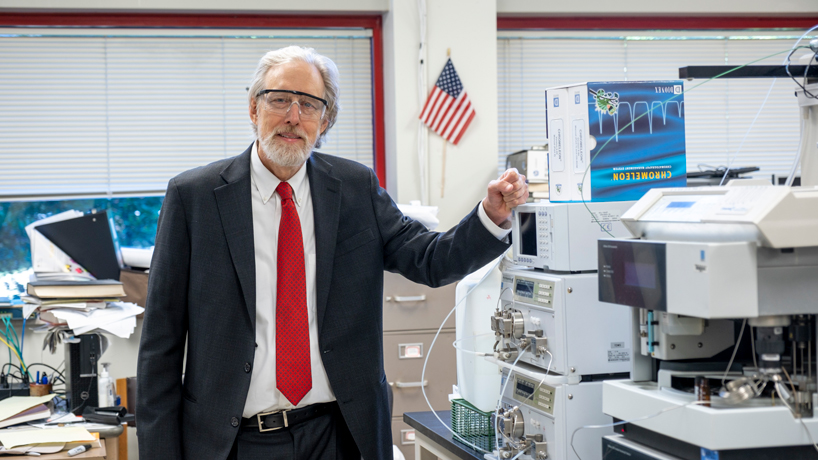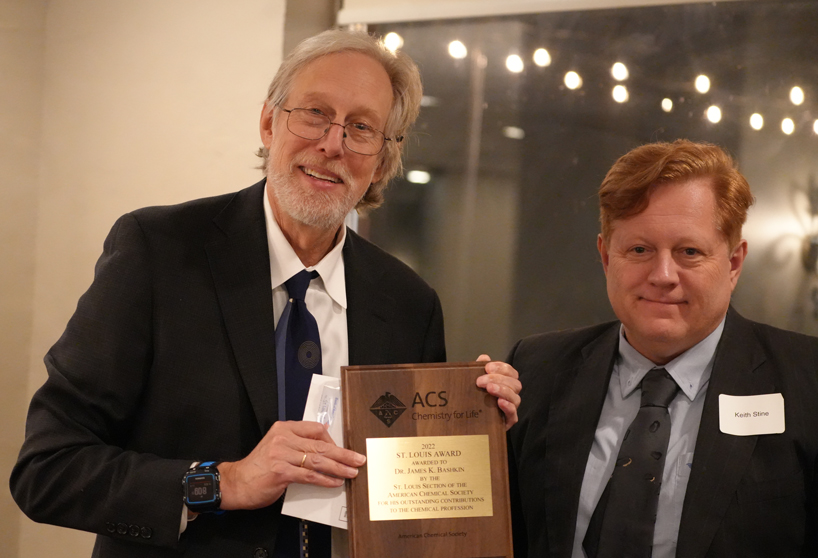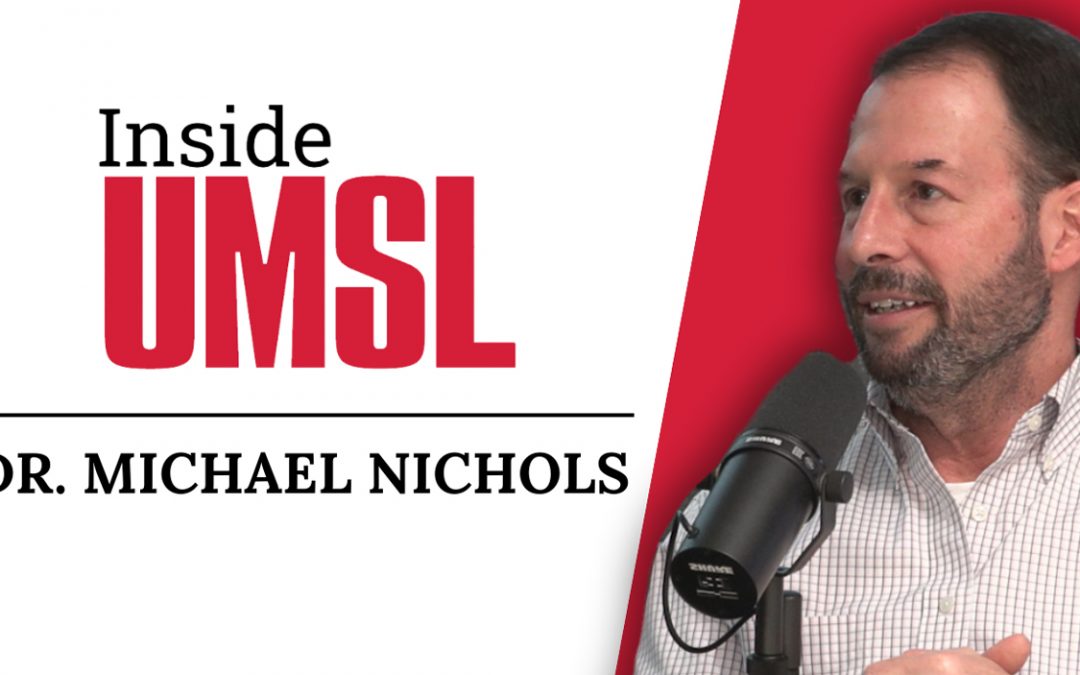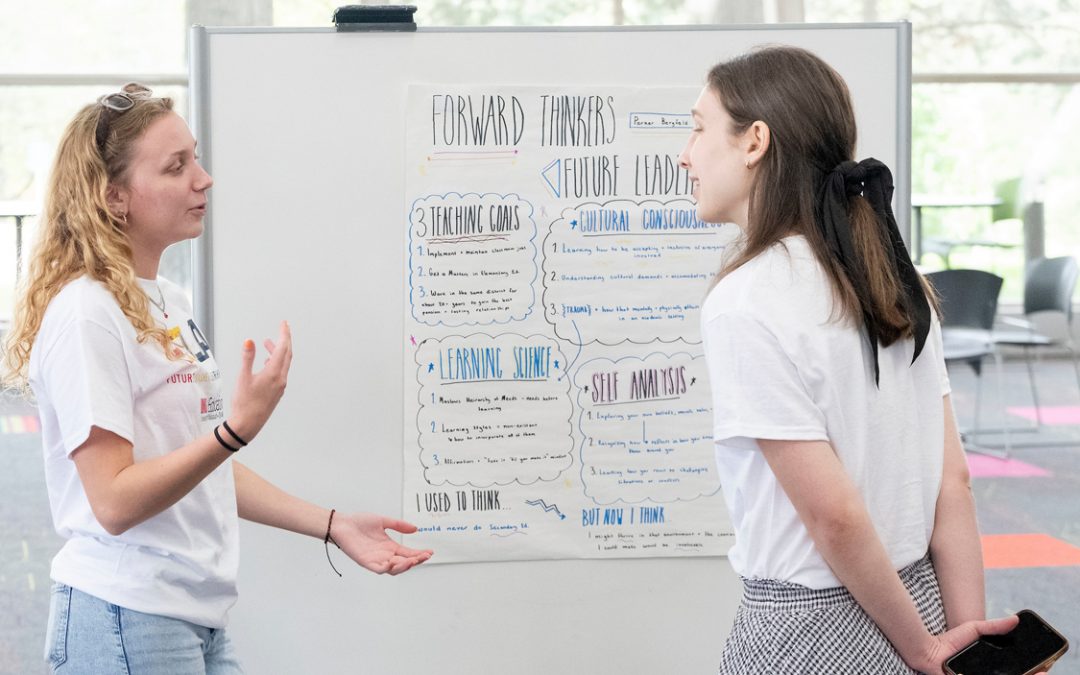
Professor James Bashkin’s lab works to develop polyamide drugs that can combat human papilloma virus, which is linked to cervical cancer. Bashkin, a professor of chemistry and biochemistry at the University of Missouri–St. Louis, was the 2022 recipient of the St. Louis Award from the the American Chemical Society’s St. Louis Section. (Photo by August Jennewein)
James Bashkin is the son of a physicist and had enough fondness for biology in high school and college that he declared it as one of his two majors.
Bashkin never completed that biology degree while studying at the University of California, Irvine. He got too wrapped up in doing chemistry research to finish the double major.
“Chemistry was just the level where I connected with science,” Bashkin said. “I didn’t take the last couple of courses I needed for the double degree – which I regret in some ways. But I don’t regret doing the research. That was a lot of fun, and I got a lot out of it.”
Most notably, that research was the foundation for a career that has spanned nearly four decades and taken him from industry to academia and back – then back once more. Along the way, he’s made significant contributions to industrial, environmental, biochemical and medical problems, including the development of a green chemistry process, deployed in the rubber chemicals industry, to create an additive used in the production of automobile tires that dramatically decreases the amount of pollution generated from that process.
Now a professor of chemistry and biochemistry at the University of Missouri–St. Louis as well as the co-founder of the company NanoVir, Bashkin’s research has shifted into pharmaceuticals. He’s been working to develop polyamide drugs that can combat human papilloma virus, which is linked to cervical cancer.
UMSL Professor Keith Stine (at right) presents colleague James Bashkin with the St. Louis Award on behalf of the American Chemical Society’s St. Louis Section at an awards banquet last Friday night at Glen Echo Country Club. (Photo courtesy of James O’Brien)
The American Chemical Society’s St. Louis Section honored him for his career full of accomplishments by presenting him with its St. Louis Award at a dinner Friday night at Glen Echo Country Club.
The St. Louis Award was established with sponsorship by Monsanto in 1970 to recognize individuals who’ve made outstanding contributions to the profession of chemistry and demonstrated the potential to further advance the profession. Bashkin is the 11th faculty member from UMSL to receive the award, and he was nominated by his friend and UMSL colleague Professor Emeritus George Gokel, himself a past honoree.
“Jim has had a varied and distinguished career,” Gokel said. “He has worked in industry, he partnered in a startup company, and he is currently an active researcher in academics. He has received a number of significant awards and has worked as a journal editor in addition to his numerous important contributions to the scientific literature. He richly deserved to be recognized with this award, and I was honored to nominate him.”
Bashkin was humbled to receive the award.
“It’s nice to be recognized by peers in the community,” he said, “so I certainly appreciate it.”
Bashkin has been part of the chemistry community in St. Louis since 1985, when he accepted his first job at Monsanto.
He’d always planned to go into academia like his father, who was a member of the physics department at the University of Iowa and later the University of Arizona when Bashkin was growing up. That remained his focus as Bashkin earned his DPhil from the University of Oxford , but he found himself suddenly drawn to a job in the industry as he completed a postdoctoral fellowship at Harvard University.
“I worked in Monsanto corporate research for six years, and I really learned a lot there and had a very exciting time,” he said. “I had great mentors and friends, including Denis Forster, Sam Tremont, Pat Lennon, John Freskos, Joe Bozell, Wille Rivers, Clark Landis and Dave Sikora.”
It was during his time at Monsanto that Bashkin helped invent a new process to make 4-aminodiphenylamine – often referred to as 4-ADPA – which can be used to make antidegradants that are used in automobile tires. The work was done through a joint venture between Monsanto and the European company AkzoNobel called Flexsys, and the new process generated 74% less organic waste, 99% less inorganic waste, and 97% less waste water than traditional methods. It has since been widely adopted around the world and helped eliminate hundreds of millions of tons of waste annually.
After six years at Monsanto, Bashkin made the move to academia, taking a position as an assistant professor Washington University in St. Louis, where he focused on inorganic chemistry.
Eight years later, in 1999, he found himself pulled into industry and returned to his old group at Monsanto. But the company was about undergo significant changes, merging with Pharmacia & Upjohn, which split its pharmaceutical and agriculture businesses. The pharmaceutical business then completed a merger with Pfizer in 2003.
Bashkin remained on the pharmaceutical side of the business through those transitions but found himself laid off – “along with about 5,000 of my closest friends,” he said – in 2003. That’s when he moved to launch his own company, NanoVir, with a virologist Chris Fisher, a former Upjohn-Pharmacia-Pfizer scientist based in Kalamazoo, Michigan.
The company designed chemicals that bind to viral DNA sequences, disrupting viral DNA maintenance in infected cells and dramatically reducing the viral DNA load of cells harboring the virus. They’ve been directing these DNA-targeting therapeutics toward the treatment of HPV.
“It’s nice to have the hope that that we might really make an impact on saving people’s lives and preventing diseases, such as cervical cancer,” Bashkin said.
As he was founding NanoVir, Bashkin also reengaged with a research appointment he had at UMSL and started working in a lab on campus. In 2011, he became fully integrated into the Department of Chemistry and Biochemistry as a professor and began training doctoral students.
The university has proved to be an ideal setting to continue his work.
“The students are marvelous for one thing, so it’s really inspiring to work with them,” Bashkin said.
He’s also found supportive colleagues throughout the department.
“They provide an atmosphere that is extremely enjoyable to work in,” he said. “I can learn a lot from them, and they’re there for me to ask questions of or to collaborate with, and I have collaborated with a number of them on grant proposals, especially with Cynthia Dupureur, whom I’ve published a lot of papers with. There’s a lot of work that never would have happened without the interaction with her.”
Many of his UMSL colleagues along with friends, former co-workers and past students were on hand to celebrate with Bashkin at Friday evening’s awards dinner as a related symposium that afternoon on Nucleic Acid Function, Probes, and Therapeutics at Benton Hall. It was the largest award reception in memory.
Bashkin expressed gratitude to them all, and to his early mentors.
“Being with such outstanding people kept the bar high for me, and always made me try to be better,” Bashkin said. “That helped me achieve a lot of things in chemistry that I might not have otherwise.”















